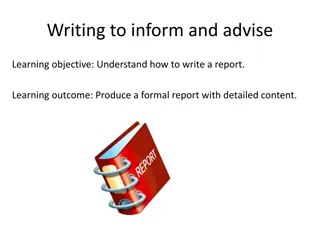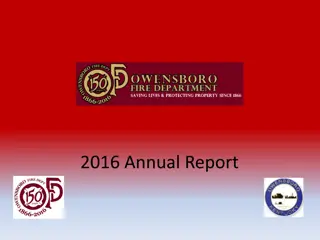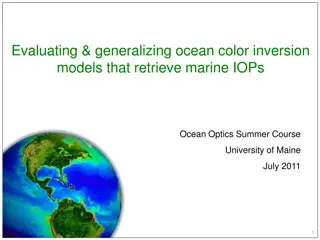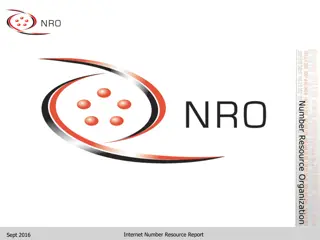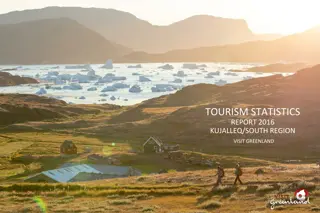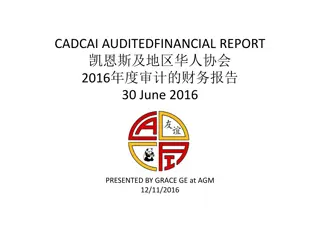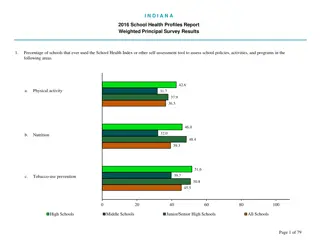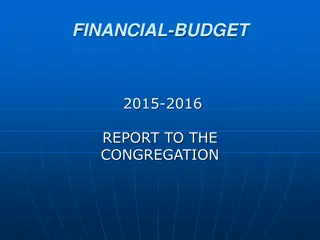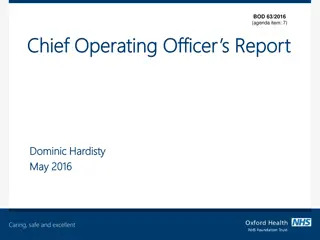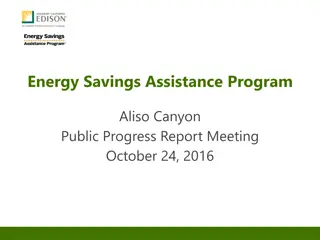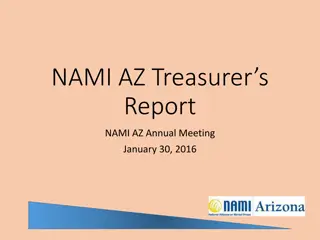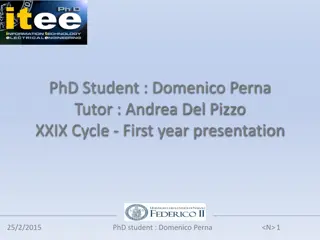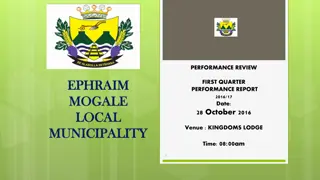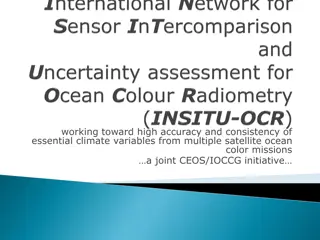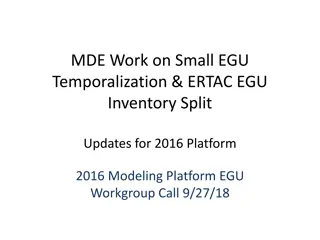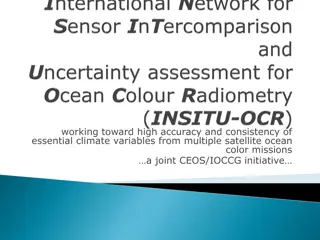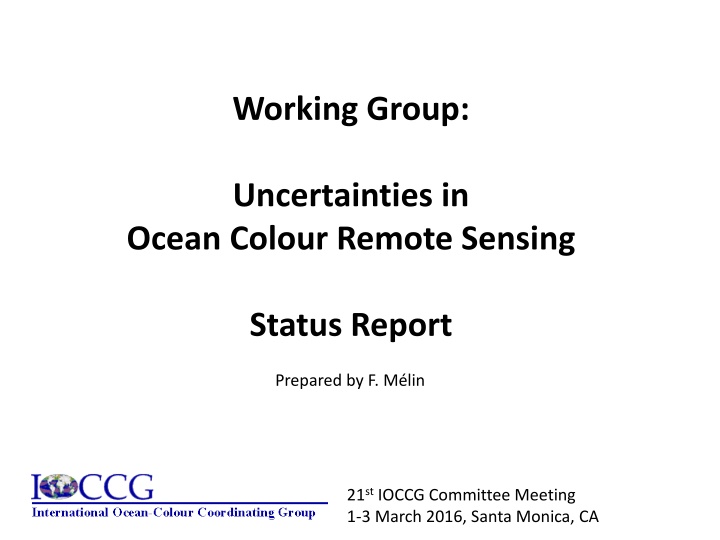
Ocean Colour Remote Sensing Uncertainties Report: IOCCG Committee Meeting Summary
Explore the uncertainties in ocean color remote sensing discussed at the 21st IOCCG Committee Meeting in Santa Monica, covering original membership, timeline, session insights on estimating uncertainty in data products, WG meeting outcomes, and terms of reference for analyzing uncertainties.
Download Presentation

Please find below an Image/Link to download the presentation.
The content on the website is provided AS IS for your information and personal use only. It may not be sold, licensed, or shared on other websites without obtaining consent from the author. If you encounter any issues during the download, it is possible that the publisher has removed the file from their server.
You are allowed to download the files provided on this website for personal or commercial use, subject to the condition that they are used lawfully. All files are the property of their respective owners.
The content on the website is provided AS IS for your information and personal use only. It may not be sold, licensed, or shared on other websites without obtaining consent from the author.
E N D
Presentation Transcript
Working Group: Uncertainties in Ocean Colour Remote Sensing Status Report Prepared by F. M lin 21st IOCCG Committee Meeting 1-3 March 2016, Santa Monica, CA
Original Membership: M. Bouvet, ESA P. Chauhan, ISRO, India R. Doerffer, HZG/BC, Germany (co-chair) S. Dutkiewicz, MIT, USA H. Kobayashi, Univ. Yamanashi, Japan E. Kwiatkowska, EUMETSAT F. M lin, JRC (co-chair) M. Wang, NOAA, USA J. Werdell, NASA, USA Additional contributions expected/received from: B. Bulgarelli, JRC B.A. Franz, NASA, USA R. Frouin, SIO, USA C. Hu, USF, USA T. Jackson, PML, UK E. Jones, MIT, USA E. Karak yl , NASA, USA S. Lavender, Telespazio, UK V. Martinez, PML, UK G. Neukermans, Takuvik, Canada M.-F. Racault, PML, UK E. Rehm, Takuvik, Canada H.U. Solanski K. Turpie, UMBC, USA
Time Line: Establishment of WG: Oct. 2011 Draft working plan: Dec. 2011 First draft version (outline + text for first 2 chapters): Dec. 2013 IOCS, San Francisco - session on uncertainties: Jun. 2015 WG 1-day meeting (San Francisco): Jun. 2015 Draft outline revised (based on meeting): Jun/Jul. 2015 New draft circulated among WG: Feb. 2016
Session at IOCS, Jun. 2015 Understanding and Estimating Uncertainty in Ocean Colour Remote Sensing Data and Derived Products Co-chairs: E. Boss, R. Doerffer, S. Maritorena, F. M lin, K. Turpie, J. Werdell - Status in the field for ocean colour, theory - Review of methods proposed for RRS and derived products: - class-based approach; - machine learning; - uncertainty propagation; - algorithm-based approach; - colocation. - Recommendations (to be taken into account in the report): - more dialogue with developers/users on the issue of uncertainty; - extend the work on uncertainty propagation; - more work to understand pros/cons of individual methods; - look at methods developed in other communities; - investigate propagation of uncertainties through Level-2/3/ ; - adopt an unambiguous language for communicating on uncertainties based on international standards.
WG Meeting, 19 Jun. 2015 Attendees: P. Chauhan, S. Dutkiewicz, B. Franz, E. Karak yl , H.Kobayashi, E. Kwiatkowska, F. M lin, M. Wang, J. Werdell Reviewed the WG Terms of Reference Revised the outline of the report and listed issues to be covered Identified the contributions and leads
Working Group Terms of Reference: analyse factors which determine uncertainties for various water types; analyse the problem of uncertainties for different product types, such as IOPs, K-values, z90 depth, concentrations; analyse the problem of uncertainty propagation in L3 and merged products; review, analyze and document methods, which allow to determine out-of-scope conditions and uncertainties including flagging; develop and compile a data set to test uncertainty and out-of-scope algorithms, recommend procedures to be implemented in ground processors and formats to present errors / uncertainties in data products; summarize the results and recommendations in the form of an IOCCG report.
Current outline 1.Introduction 2.Sources of uncertainties 3.Uncertainty Estimates 4.Representation and distribution of uncertainties 5. Requirements from different applications of Ocean Colour data 6. Recommendations
Chapter 2. Sources of uncertainties 2.1 Uncertainties of input data TOA data Ancillary data 2.2 Uncertainties associated with models and algorithms Atmosphere (aerosols, Rayleigh ) Effects of clouds, ice, land (adjacency ) Sea surface (glint ) Optical properties of water constituents Vertical distribution of water constituents Relationship between IOPs and AOPs and bidirectional effects Chapter 3.Uncertainty Estimates 3.1 Use of field observations 3.2 Methods for identifying out-of-scope conditions and estimating uncertainties of ocean colour products 3.3 Current knowledge on uncertainties (RRS, derived marine products, aerosols, PP, PAR) 3.4 Verification of uncertainties
Methods currently considered in Section 3.2 of Chapter 3 Uncertainty estimates from algorithm construction Clear-water approach (algorithm-based) The Clear-water approach relies on the comparison the outputs of 2 Chla algorithms (i.e., OC4 and OCI color-index). Rrs is assumed error- free when the 2 algorithms provide the same Chla values. The Rrs uncertainties are then determined as the standard deviation of Rrs generic values with respect to the reference error free Rrs for specific Chla values determined with OCI. Uncertainties of SeaWiFS and MODIS/Aqua Rrs data for the North Atlantic (NA) and South Pacific (SP); Hu et al. (RSE 2013). Class-based approach In a class-based approach, validation statistics are first defined for each class (or optical water type) using a match-up data base linking satellite and in-situ data. Then any input data (e.g., Rrs ) can be classified and its validation statistics associated with the relevant class. So, if an input is found as fully belonging to a class, its uncertainty value is that of that class. RMSD for log(Chl) from match-ups and optical water types (Moore et al. 2009); Sathyendranath et al. (in prep)
Outputs of non-linear inversion methods Bayesian approach Use of simulated data Analytical uncertainty propagation In the analytic approach the expected uncertainty affecting Rrs is propagated to the derived products (e.g., Chla). Relationship between an error on RRS of different signs for the blue and green bands input to the OC4v6 maximum-band-ratio algorithm
Comparison of satellite products Collocation techniques Collocation relies on the accumulation of matching data from 2 or more satellite data sets. A mathematical development leads to the computation of the part of the uncertainty budget associated with random effects and called . Rrs uncertainty associated with random effects (M lin et al., RSE 2016) log(Chl) uncertainty associated with random effects (M lin, IEEE 2010) Methods for specific products (e.g., PFTs, .)
Chapter 4. Representation and distribution of uncertainties 4.1 Out-of-scope flags 4.2 Uncertainty distribution 4.3 Current distributions Chapter 5.Requirements from different applications of Ocean Colour data 5.1 Modeling Community 5.2 Climate Research 5.3 Environmental Monitoring 5.4 Phenology Studies 5.5 Fisheries Applications
New Time Line: Complete draft: June 2016 Final draft: September 2016

